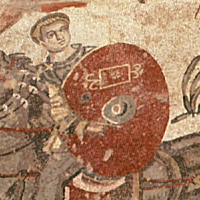
This page created 17 May 2014, and last modified: 8 December 2015 (references rearranged)

The Equites octavo Dalmatae is listed (102/5.15 in Ingo Maier's numbering scheme) as the third of the 32 vexillationes comitatenses units in the Magister Equitum's cavalry roster; it is assigned (102/5.225) to his Gallic command. Its shield pattern (100#13), as shown in various manuscripts under the simple label (100.n) Dalmatae, is as below:

The shield pattern is rather complex. It features a white ground with a white central disc, from which radiate seven spikes. It appears there is spacing for eight, albeit the 12 o'clock position is instead taken up by an indigo (faded in M and white in B) voided billet, to use the language of medieval heraldry (i.e. a rectangle with the centre taken out), and indeed W shows 8 spikes, albeit without the billet. The central disc shows a green six-petalled flower (seven-petalled in O) with a blue (O, P), white (W, B) or yellow (i.e. faded green) central portion (M), where the boss would be positioned; the petals bisect the positions of the spikes rather than align with them in O. Each of the spikes is shaded (except in B), with indigo (faded to maroon in M and W, and absent in B); the shading is on the trailing edge going clockwise around the shield. The billet/rectangular box probably represents a small imago - an Imperial portrait, albeit at a scale too small to have been successfully drawn. The 12 o'clock position is typical for such portraits (e.g. see the Sagittarii iuniores Gallicani, 9.30), and was a particularly common position for shield decorations generally to appear during the Tetrarchy, 100 years before the Notitia was compiled; an example of a cavlaryman's shield showing such a rectangular motif can be seen in the Piazza Armerina mosaics in Sicily, as shown below:

The name Dalmatae comes from Dalmatia, from where a dozen or so auxiliary infantry cohorts were recruited in the first century; a few of these kept their names intact long enough to make it into the Notitia, such as the men under the Tribunus cohortis secundae Dalmatarum (154.27), responsible to the Dux Britanniarum. However, the great majority of Dalmatae units in the Notitia are, like the Equites Dalmatae passerentiaci, cavalry units. They seem to have been a major component of the much-expanded cavalry forces raised in the 3rd quarter of the 3rd century; exactly how "Dalmatian" cavalrymen were distinguished from those of other units is not yet understood.
The Equites octavo Dalmatae (i.e. "the Eighth Dalmation Horse") is part of a series of numbered Dalmatian cavalry units in the Notitia; one can also find the:
Equites tertio Dalmatae (15.5), a vexillationes comitatenses under the Magister Militum per OrientemPresumably at some point there were also units numbered I, II, IV, and VII. However, most Dalmatian cavalry units in the Notitia are not so-numbered; a few have a name, such as the Equites Dalmatae passerentiaci (102/5.16), but most are limitanei units that are just described as "Equites Dalmatae", along with their station name.
Equites quinto Dalmatae (9.11), a vexillationes comitatenses under the Magister Militum Praesentalis I
Equites sexto Dalmatae (12.11), a vexillationes comitatenses under the Magister Militum Praesentalis II
Equites nono Dalmatae (9.12), another vexillationes comitatenses under the Magister Militum Praesentalis I.
Inscriptional evidence for the Equites octavo Dalmatae comes from the cemetery at Colonia Iulia Concordia (modern Portogruaro in Veneto, Italy), which produced two inscriptions mentioning the unit; the first (CIL 5,8777) in the form of the NU E[q]VI VIII DALM[...], and the second (ILS 2805; photo here) in the form NVMERO OCTAVA DALMATAS.
1. Ingo Maier; "Appendix 4: Numeration of the new edition of the compilation 'notitia dignitatum' (Cnd)"; last accessed 26 October 2015. See also for here for numbering examples. Return
2. Dietrich Hoffmann; "Die Spätrömischen Soldatengrabschriften von Concordia"; Schweizerische Zeitschrift für klassische Altertumswissenschaft, Vol. 20.1 (1963), pp 22-57 (1963), available here (last accessed 8 December 2015). Return

Return to the Notitia alphabetical unit list page.
Return to my Notitia index page.